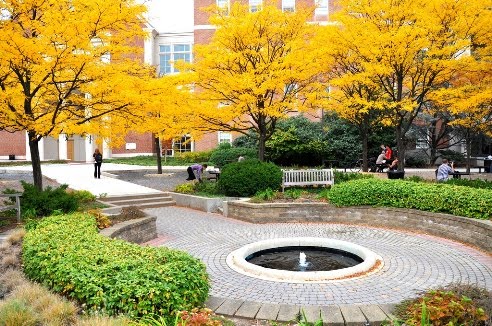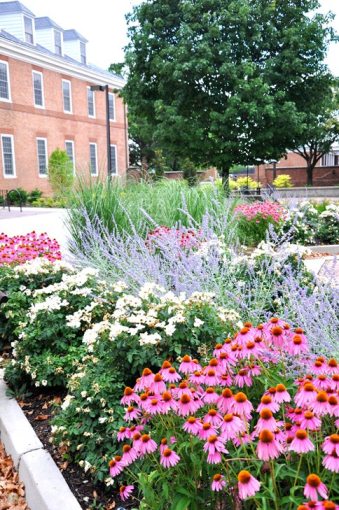While I have never had the opportunity to visit California, it is easy for a horticulturist to pick up on and notice the unusual and often lush tropical and subtropical plant materials in Facebook posts to plant groups by California gardeners or in the pictures taken in or movies filmed in southern and coastal California. What, that movie actually had actors? It is difficult for a plant nerd like myself not to lust after these tropical and subtropical beauties and experience plant envy, especially during the cold days of January and February in Maryland!
California Dreamin has been part of the American experience for a far longer time than when John and Michelle Phillips first created their popular hit with that name. There was a gold rush among many other dreams of striking it rich in the exotic state of California; however, for many inhabitants of the southern Great Plains (Kansas, Oklahoma and Texas) of the United States, in the 1930's during the Dust Bowl years, making it to California represented hope, the hope of survival and the hope of escaping a miserable situation. PBS created an excellent special feature on the American Experience called 'Surviving the Dust Bowl' that documents this sad time. The concept of California Dreamin has meant different things to many people over the years. However, those different dreams had one thing in common, they created excitement about new possibilities!
While growing up many years ago in Kansas, a state located in the heartland of the United States, I became very familiar with California Dreamin, as it was a wonderful tune that our talented high school band instructor, Mr. Michael Salaway, a native of another exotic state named New Jersey, located on the opposite coast from California, picked out for us to play. This song expresses the creators, John and Michelle Phillips, longing for the warmth of California during a cold winter according to Wikipedia. At our tiny school, Gridley Rural High School, since combined into Southern Coffey County High School, about 3/4 of the students were enrolled in the combined junior high and senior high school band. Fortunately, we got to play this song a lot as many of us including myself needed a lot of practise. I was not a talented musician, but I enjoyed playing anyway, especially the trombone part for 'California Dreamin.' I can still hum my favorite portion of the trombone part some 36 years later. It isn't very often that trombone players get to play the melody, let alone such a wonderful melody as in this tune. While the voice version is nice, I like the big band version even better. Could not find the same version on You Tube that we played in band; however, this version by the OGO Big Band has some outstanding trombone playing as well as a great flute solo that create a magical experience for me.
My hope was that the use of the greenhouse space would allow us to do something different, to use some plants that we might not ordinarily have access to that might provide a magical moment or experience for people that work on or visit our campus. When you create landscapes with magical moments, they are uplifting to the human spirit. To me, a magical moment might be seeing the large, boldly textured and colored leaves of 'Siam Ruby' Bananas rising above a sea of 'Shenandoah' Switch Grass. Or someone smelling the wonderful fragrance of 'Zephirine Droughin' Rose, 'Summer Nocturne' Crinum Lily or Common Jasmine. Or someone seeing a tiny iridescent green ruby-throated hummingbird for the first time, hovering in midair and feeding on the incredible intense blue flowers of 'Blue Ensign' Anise-Scented Sage or Salvia, before it disappears in a flash. Many spectacular Salvias are not commonly used in our area because that they are annuals in our climate and do not bloom until late summer or early fall. It is very hard for a greenhouse or nursery to sell plants that are not in bloom when the customer buys them in the spring. Color sells! Magical moments are not just about the use of unique plant materials, they are also about carefully placing plants and other materials together in a way that a landscape sings and is uplifting. Thank you Ann Petrone! Some people refer to uplifting landscapes as sacred places.
Many people plant out tropical and subtropical plants for the summer in the colder temperate zones. Usually the plants die come winter in colder temperates zones, unless special precautions are taken. These precautions may include cutting back to the ground after frost kills the tops and applying an extra thick layer of mulch to insulate the rhizomes or crown area from the winter cold. Some plants do well in an unheated basement over the winter as long as it stays cool (40-50 degrees F), but does not freeze. Many plants can be simply dug up from the garden and placed in a cool basement without a need for potting them up. Very little to no watering is usually best for most of these plants when that they are dormant in a basement. Some can be cut back before placing in a basement and others it is better not to cut back. A few lucky gardeners may have a greenhouse to overwinter tropical plants. However, often insect pests can be a big problem when overwintering plants in a greenhouse. Some tropical and subtropical plants such as Crinum Lilies do not reach their full potential for flowering and/or beauty in one year from tissue culture or small mail order plants. Crinum Lilies may not bloom at all the first year from tiny mail order plants like those that we purchased. However, the size and number of shoots did increase dramatically. We will need to overwinter them in a greenhouse before we get a good return on investment in blooms from them.
No, I was not content to limit my vision of California Dreamin to tropical and subtropical plants, I expanded my vision to include some hardy and marginally hardy plants that were not available from our local vendors. I wanted to trial some plants that I felt had good ornamental potential. Plants such as Hardy Ground Orchid (Bletilla ochracea and Bletilla striata), 'Pink China' elephant Ear (Colocasia 'Pink China'), Carolina Jasmine (Gelsemium sempervirens), Japanese or Hardy Banana (Musa basjoo), 'Thai Black' Banana (Musa 'Thai Black'), 'Mekong Giant' Hardy Banana (Musa xishuangbannaensi), Hardy Jerusalem Sage (Phlomis tuberosa), 'Belinda's Dream' Rose, 'Carefree Beauty' Rose, 'Ducher' Rose, 'Zephirine Drouhin' Rose, Arizona Blue Sage, Blue Turkish Sage and Romanian Sage.

'Carefree Beauty' is a rose that I have been wanting to try for a number of years. It is a rose that is very highly rated by a number of different rose society's located in some of our nations harshest climates where that it is difficult to grow many plants. 'Carefree Beauty' is one of a number of lovely and very cold hardy roses bred by the late Dr. Griffith Buck, a plant breeder at Iowa State University. This website maintained by Iowa State University has a listing with pictures of a number of the Buck Roses. Disease resistance was built in to Dr. Buck's breeding program as he did not have the budget to spray the plants in his program. Those roses that were disease prone died and were no longer a part of the breeding program. Dr. Buck was breeding and growing disease resistant roses, long before that the concept occurred to others. A horticulture friend from the Kansas City area has tried a number of the Buck roses and gave them a thumbs up as being great, durable roses.
So far, the 'Carefree Beauty' Roses that we received by mail order and grew in the Research Greenhouses and then planted out on campus have far out performed a highly touted English Rose that I attempted to grow years ago and a couple of over publicized Flower Carpet roses that we removed from the Benjamin Garden because of their poor performance. My disappointment in the over rated English Rose was so great that I never grew roses for many years after that until I saw how amazing that the Knock Out series of roses were. 'Carefree Beauty' is one of the parents of the original 'Knock Out' Rose. The pink color of the 'Carefree Beauty' Roses contrasts beautifully with the electric blue color of 'Blue Ensign' Anise-Scented Sage or Salvia planted in the Benjamin Courtyard Garden.
My 'California Dreamin' started to become a reality when that administrators approved the mail order purchase of the plants that I had selected. Ken Ingram helped my pot up newly arrived mail order plants during sping break while others were in Florida or some other exotic location. Someone else has always grown the plants that I have used over the years, rather than me being the greenhouse grower, so I received quite an education this spring. Luckily, Ken and the talented folks at the Research Greenhouses helped me along the way. It was a great learning experience that provided some unusual plants for us to trial. I am still learning about these plants and hope to be able to share more information about them in the future. It won't be until next Spring that I will know if that the plants that are supposed to be winter hardy, turn out to be winter hardy as we were told etc.
Below is a scene that is far more exciting to a plant nerd like myself than when I was a kid opening presents at a family gathering. This was the largest of three different orders that we placed. It was also the most carefully wrapped. No damage in transit with this order! Clear plastic tape was used everywhere, and I do mean everywhere. It took longer to extricate the plants from all of this packing than that it took to replant them into larger pots.
 |
| Carolina Jasmine or Carolina Jessamine (Gelsemium sempervirens) came with a single bloom! |
 |
'Double Purple' Angel's Trumpet (Datura fastuosa 'Douple Purple' or Datura metel 'Double Purple')
|
 |
Unpacked plants ready to go into the greenhouse to be planted in larger size pots over the next few days.
|

 |
Red Abyssinian Banana (Ensete maurelii) planted northwest of the West Chapel on August 19, 2013.
|
 |
'Zebrina' Blood Banana (Musa acuminata 'Zebrina') planted northwest of the West Chapel on August 19, 2013.
|
 |
'Blue Ensign' Salvia or Sage (Salvia guaranitica 'Blue Ensign') in the Benjamin Building courtyard garden on August 27, 2013
|
 |
Blue Taro or Elephant Ear (Xanthosoma violaceum) in a front foundation planting at Tawes Hall on August 27, 2013
|
 |
Japanese Hardy Banana (Musa basjoo) in a front foundation planting at Tawes Hall on August 27, 2013.
|
 |
Carolina Jasmine and Common Jasmine in the back of the pickup truck waiting to be planted on July 16, 2013.
|
 |
Newly installed Carolina Jasmine and Common Jasmine planted on a trellis southwest of Tawes Hall on July 16, 2013. Existing 'Dropmore Scarlet' Honeysuckle vines were cut back to just a few inches.
|
 |
Hardy Jerusalem Sage (Phlomis tuberosa) This one is supposed to be hardy for us! It has certainly done well for us during this recent dry spell this year. Picture taken on August 28, 2013.
|

































